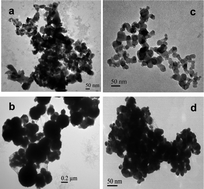Brine shrimp (Artemia salina) larvae were exposed to different sizes of zinc (Zn) and zinc oxide (ZnO) nanoparticles (NPs) to evaluate their toxicity in marine aquatic ecosystems. Acute exposure was conducted in seawater with 10, 50 and 100 mg L−1 concentrations of the NPs for 24 h and 96 h. Phase contrast microscope images confirmed the accumulation of the NPs inside the guts. Artemia were unable to eliminate the ingested particles, which was thought to be due to the formation of massive particles in the guts. Although the suspensions of the NPs did not exhibit any significant acute toxicity within 24 h, mortalities increased remarkably in 96 h and escalated with increasing concentration of NP suspension to 42% for Zn NPs (40–60 nm) (LC50 ∼ 100 mg L−1) and to about 34% for ZnO NPs (10–30 nm) (LC50 > 100 mg L−1). The suspensions of Zn NPs were more toxic to Artemia than those of ZnO NPs under comparable regimes. This effect was attributed to higher Zn2+ levels (ca. up to 8.9 mg L−1) released to the medium from Zn NPs in comparison to that measured in the suspensions of ZnO NPs (ca. 5.5 mg L−1). In addition, the size of the nanopowders appeared to contribute to the observed toxicities. Although the suspensions possessed aggregates of comparable sizes, smaller Zn NPs (40–60 nm) were relatively more toxic than larger Zn NPs (80–100 nm). Likewise, the suspensions of 10–30 nm ZnO NPs caused higher toxicity than those of 200 nm ZnO NPs. Lipid peroxidation levels were substantially higher in 96 h (p < 0.05), indicating that the toxic effects were due to the oxidative stress.

You have access to this article
 Please wait while we load your content...
Something went wrong. Try again?
Please wait while we load your content...
Something went wrong. Try again?


 Please wait while we load your content...
Please wait while we load your content...